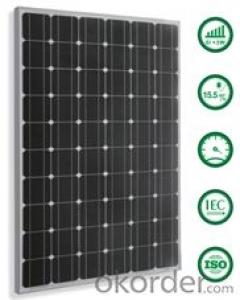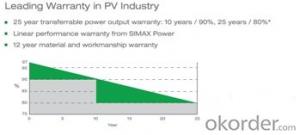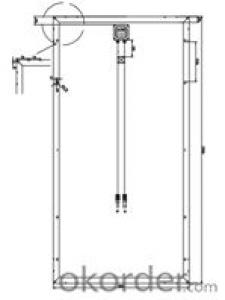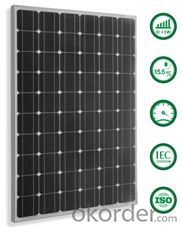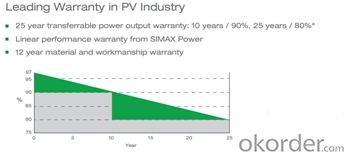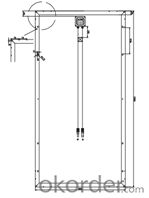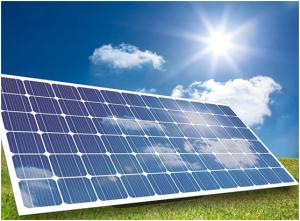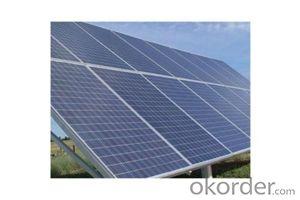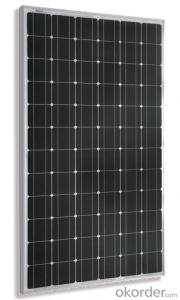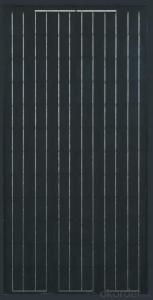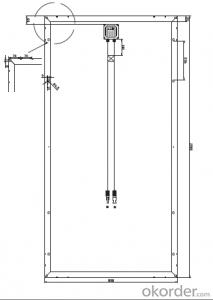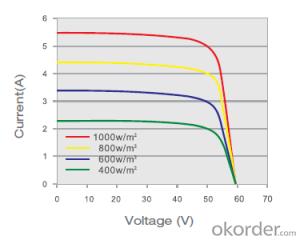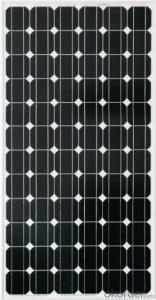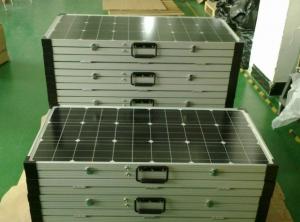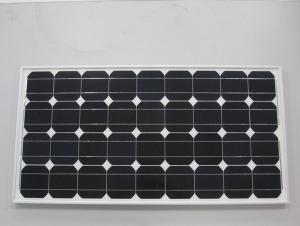Recc Solar Panels Monocrystalline Solar Module SM572 195W
- Loading Port:
- Shanghai
- Payment Terms:
- TT OR LC
- Min Order Qty:
- 25 set
- Supply Capability:
- 8000 set/month
OKorder Service Pledge
OKorder Financial Service
You Might Also Like
Product Description:
1.Structure of Monocrystalline Solar Module SM572 195WSeries Description:
Monocrystalline Solar Module SM572 195W: High efficiency crystalline solar cell. Even if under the weak light, the solar module can produce maximum power output.
II Tempered glass (toughened glass): Anti-reflecting coating and high transmission rate glass increase the power output and mechanical strength of solar module.
III EVA and TPT: Using high quality EVA and TPT to prevent destroying and water.
IV AI frame: Without screw, rner connection. 6 holes on the frame can be installed easily.
V Junction box: Multi function junction box with water proof.
VI Long lifetime: ≥25 years; Less power decrease.
VII Good performance of preventing from atrocious weather such as wind and hails.
VIII Resisting moisture and etching effectively, not effected by geology.
IX The certificate issued by international authority: TUV, IEC, CE.ISO9001.MCS
2. Standard Test Conditions of Monocrystalline Silicon Solar Panel:
The opto-electrical specifications shown below are stabilized values being measured at Standard Test Conditions, Irradiance: 1000W/m2, Spectrum: AM1.5 at 25°C, The info below is subject to manufacturing tolerances. Where appropriate minutes of measurement are available and are used for the dimensioning of the installation.
Advantages of Polycrystalline Silicon Solar Panel
• 25 year transferrable power output warranty: 10 years / 90%, 25 years / 80%*
• 12 year material and workmanship warranty
• Timeliness of delivery
• Quality Products certified (TUV, IEC, CE.ISO9001.MCS)
3. Characteristics of Monocrystalline Silicon Solar Panel:
• Guaranteed tolerance +3%
• High manufacture standards
• Reliable power output
• High module efficiency
• Module efficiency up to 15.5%
• Cells efficiency up to 17.6%
• Strong compressive strength
• Certified to withstand high wind of 2400Pa
4. Solar Panel Images
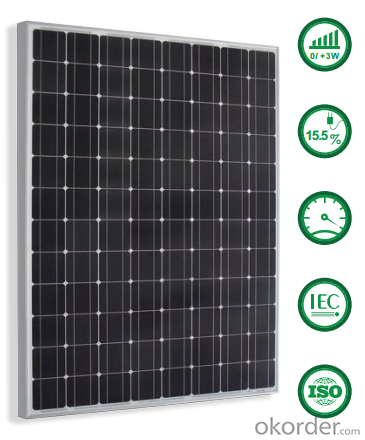
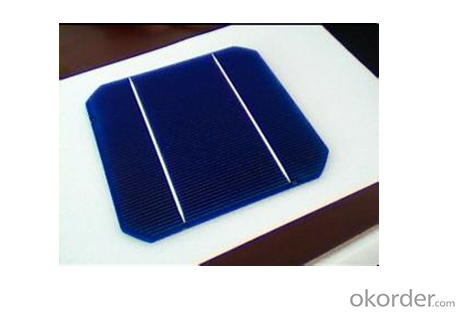


5. Monocrystalline Silicon Solar Panel Specification
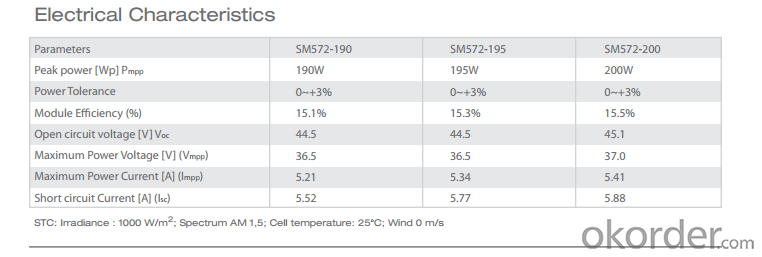
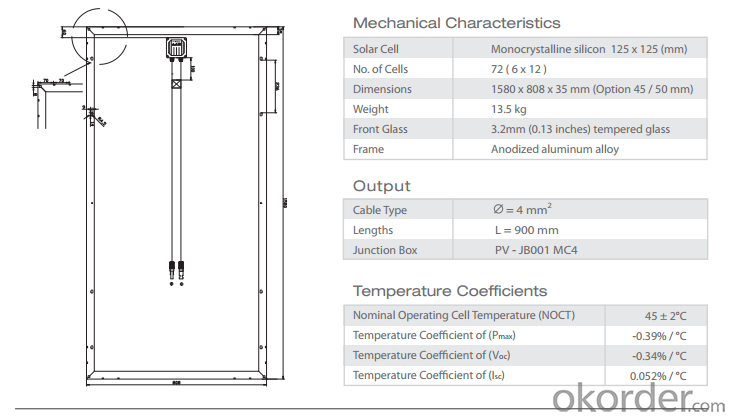


6.FAQ
We have organized several common questions for our clients,may help you sincerely:
①How about your company?
We are a private-owned high-tech company who specializes in developing, manufacturing and marketing of silicon ingots, solar wafer, solar cells, solar modules, PV systems and solar applications products.
At present, We has one research & development team, whose members are well-known experts in photovoltaic area. We also have advanced production and test equipment.
②How to guarantee the quality of the products?
Our products have been certified by CE, CEC,MCS, IEC61215, IEC61730 and ISO9001.
• 25 year transferrable power output warranty: 10 years / 90%, 25 years / 80%*
• 12 year material and workmanship warranty
• Timeliness of delivery
• Quality Products certified (TUV, IEC, CE.ISO9001.MCS)
③How long can we receive the product after purchase?
In the purchase of product within three working days, We will arrange the factory delivery as soon as possible. The pecific time of receiving is related to the state and position of customers.Commonly 7 to 10 working days can be served.
- Q: Can I fet free solar panels. This site okorder sells a book that tells how to, but I ordered tha book more then a year a go, and in never came. I even sent them a email a day for more then 3 months and never heard back from them. If anyone knows how to get free pannels, please let me know how. A $300.00 a month bill is slowly killing me.
- Try approaching a few power suppiers to find out if they have any scheme or grants available. Or contact a local DIY store/builders merchants and ask if you can have some panels installed and agree to advertising allowing them to let people contact you for your opinion on the panels.
- Q: What is the biggest solar panel you can buy?How much energy can it produce in kwh?Thanks :)
- There are panels made up to about 250 watts. You string them together in series/parallel to get more power. Depending on your average insolation, a 250 watt panel caqn produce anywhere from a kwh/day to two kwh/day (averaged over the year - it's less in the winter and more in the summer and can range from 0 to three kwh/day). Powering a city also requires energy storage for nightime or cloudy days. The cost of this can exceed the cost of the panels by a factor of three. DK
- Q: I need to find a way to clean solar panels that automated, at best;A way beside using a large 'squeegee'
- Hire Tinkerbell, Disney hasn't had much for her to do lately.
- Q: How do solar panels convert sunlight into electricity?
- Solar panels convert sunlight into electricity through a process called the photovoltaic effect. When sunlight hits the solar panels, the photons in the sunlight excite the electrons in the solar cells, allowing them to flow and create an electric current. This current is then captured and converted into usable electricity, which can power various devices and homes.
- Q: Do solar panels require direct sunlight to work?
- No, solar panels can still generate electricity even in indirect or diffused sunlight.
- Q: Okay, I think I understand what I'm doing, but I want to set up some solar panels on the roof of my garage, the building that gets the most sun, and I want to make sure all my math is correct in determining number of megawatts per year. However, my knowledge of electrical terms in quite n00bish, to say the least.Here is what I think I should be doing.The solar cells come at .75 Watts average power.I will install 4 panels of 64 cells each, with a total of 256 cells.
- For comparison, 36 of these make a normal 2V x 50W panel. Note they are not tabbed. This means you have to find a way to connect them yourself. The tabs are probably spot welded on by the suppliers. A supplier below has kits of these with tabs, as needed to connect them together. These are not suitable for grid connect, because the higher voltage needed makes do it yourself panels a dangerous and litigious thing to have on your roof. Maybe you could buy a smaller pack from the link below to compare tabbed and untabbed and work out what to do. Your power calculation is a bit incorrect because the sun is only present some of the time. The 36 cell module would produce 50W when square on to the full sun. The sun may be out for around 2h a day in some places and times of the year. However it is the equivalent of 5h full sun, because of the changing angle throughout the day. Look this up on the internet for your region. Temperate zones may be a lot less. One pack in your link is 36x3 = 08 cells. Thus 50W per pack x 5h a day gives 750Wh per day and 274KWh/y. In reality it will always be less because of regions, weather, clouds, dust, inefficiencies, aging of cells.
- Q: What would it take to make a heater for a small solar panel. I am looking into making a heater for a livestock tank to keep ice melted. I know that heaters take alot of energy to run, but my theory is that if heated mirrors on a car can melt ice with low voltage and im sure not extreme heat (40-60 degrees) then making a heater with just high enough temperature to keep from icing over and melting ice is possible. Where do I start? I would like to use an inexpensive solar panel that will generate enough heat to keep ice from forming and melt it at the beginning of the day. How can you make such a heater and apply Ohms law so that it will function correctly, what Wattage will the pannel need to produce to generate enough heat for the heater. The device will only have to be large enough to melt a spot large enough for an animal to drink.
- Absolutely. But I see your point about the Ohms law. I think you'd need technical schematics to get the raw details.
- Q: I know the basics of how solar panels work. Solar panels convert sunlight into DC electricity which is stored in batteries which would need to be run through an inverter to convert it to household AC. But is there a way for the appliances to use the solar panels electricity FIRST and any additional power from the grid? Is that how it works or do they only run specific devices(water heater, pool pump, etc)?
- The batteries are inefficient and expensive. Lead acid batteries are 95% efficient at discharging but only 50% efficient at charging so you need double your power consumption in solar panels for a battery based system. The big breakthrough was in grid tied inverters, these can be connected to the grid and synchronizes it's frequency to the grid thereby selling the solar power to the grid. The house electric system remains on the grid so you buy back the power when you need it effectively turning the grid into a 00% efficient battery by accounting. This saves you the cost of the batteries and the inefficiencies of the batteries halving the number of panels that you need. Grid tied solar can be a third the price of a comparable battery based system. The utilities will usually still have a service fee and may have limitations such as you can only sell the amount of power that you use and the sale can only be credits versus future energy purchases. There will also be the inefficiencies of the grid tied inverter but it would be at full load which is when it is the most efficient often 95% whereas the partial load use of a battery based system operates the inverter at an average of 65% efficiency which is why DC appliances are highly recommended for a battery based system.
- Q: Are solar panels worth it?? I mean the price you by for them up front is a lot, so you properly need a loan for it. So how does it work? Won't the loan be just as much as you electric bill?Im just really confused about it.
- Solar panels are one of today's best investments! With a lifespan of 25 to 30 years minimum, and a payback period of 0 year or less, the economics are a no-brainer. There are often state loan programs giving you low interest or no interest for a length of time. There are also tax credits and rebates that take care of a lot of the up front money. Calculate for yourself what you will pay to your utility over the next 30 years. Then see how the cost of a solar electric system compares. My company has helped scores of homeowners and business owners claim Independence and take control of their energy costs for the next few decades. Contact us to have a site evaluation and payback analysis for your particular situation.
- Q: How many solar panels do you need on your house to power your heater in winter?
- You can get over 5 times the efficiency at lower cost by directly absorbing the heat in a solar water-heating collector. Use the electrical panels for making electricity for stuff that needs it.
Send your message to us
Recc Solar Panels Monocrystalline Solar Module SM572 195W
- Loading Port:
- Shanghai
- Payment Terms:
- TT OR LC
- Min Order Qty:
- 25 set
- Supply Capability:
- 8000 set/month
OKorder Service Pledge
OKorder Financial Service
Similar products
Hot products
Hot Searches
Related keywords
